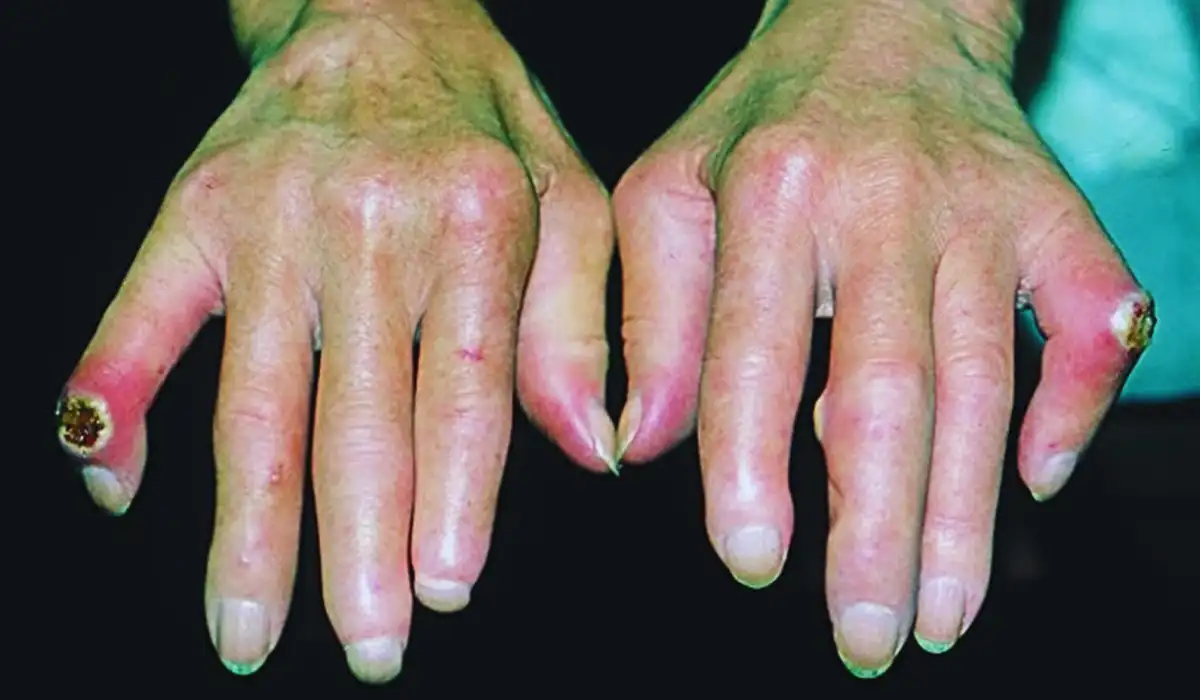In today’s world of new health conditions and challenges that threaten our survival, it’s important to stay aware and cautious and have a basic insight to maximize your benefit.
In this article, we will discuss one such condition named Scleroderma a condition that is believed to be influenced by both genetic predisposition and environmental factors.
With the ability to anyone, even children and women let’s unravel what you need to know to be one step ahead.
This article discusses who is most likely to be affected, what are its symptoms, and its causes accompanied by suggesting the best cause of treatment.
What is Scleroderma?

Let’s first understand what Scleroderma is, in brief, it is a condition or group of diseases that cause changes in the skin, blood vessels, muscles, and internal organs. Simply an inflammation or fibrosis, thickening to the skin and other body areas.
It confuses the immune response as if it is an injury which contributes to the reason behind the inflammation. There are two known variants of Sceleroderma which is the localized Scleroderma which only affects the skin and beneath it.
At the same time, the second type is Systematic Sclerosis which affects many systems in the body that have major functions such as the organs which include the heart, lungs, and kidneys. As of now, it is said that there’s no cure for this condition.
Who gets Scleroderma?
The condition is not selective when it comes to people as it can affect anyone even children.
But still middle age women between the ages of 30 and 50 are targetted but no exception when it comes to anyone else.
What’s interesting is the fact that the cause and reason behind its occurrence are still a mystery.
Studies back up the influence of environmental factors and genetic predisposition has its role which is the only valid evidence as of now.
What are the Symptoms Of Scleroderma?
It’s time to unravel the symptoms to confirm whether you are about to encounter Scleroderma. Let us look at the major signs in detail
- Skin tightening and Thickening
The tightening of the skin is a major sign to confirm and it is most likely to occur on the hands, face, and a few other areas. You can easily spot the changes in a couple of days and must immediately connect to an expert.
- Raynaud’s Phenomenon
Fingers turning to white or bluish color in terms of their response to cold and stress is a weird but important sign for you to seek medical attention.
This phenomenon is named Raynaud’s Phenomenon and the body’s sign of showing you vascular changes.
- Difficulties in Digestion
The signs or changes Sceleroderma brings to the body wouldn’t be maintained by the immune system of the digestive organs and thus cause difficulties in swallowing or heartburn on the surface. It extends the reach to any part of the skin and beyond.
- Joint pain
Last but not least, having pain in the joints caters to various conditions and diseases but also plays its role here as well.
With usual discomfort within the joints of arms or legs, it’s also an obvious sign of Sceleroderma.
Causes behind Scleroderma
This might be hard but there haven’t been any studies or research that proves or points out its causes in any way.
The origin remains a mystery but the glimpse of what we got points out to the genetic and environmental factors.
Viral infections, exposure to toxic chemicals, and hormonal changes are said to be contributing to the initiation of scleroderma in individuals who are suspected to encounter or already encountered backed studies.
Treatment for Scleroderma
Navigating the treatment or taking necessary precautions once you spot the signs can be confusing as well as challenging.
Especially when the condition’s origin isn’t explained experts believe there aren’t any cures.
But temporary or keeping safety is possible with meds such as immunosuppressants that can be used to slow down issues related to skin and excessive response.
- Medications: As mentioned few prescribed meds can provide piquant solutions. Immunosuppressants are the most recommended by the experts when it comes to slow relief.
- Physical Therapy: When symptoms like joint pain come to play physical therapy is a great solution. Physical distress like joint pain and stiffness can be cured by an expert with proper exercises and treatment to put you in a better position.
- Lifestyle Adjustments: A good way of living manifests into great health, mental peace, and overall well-being.
- A good diet, and staying physically active with exercises reduce the chances of any risks. Habits like smoking and eating fast foods with high sugar are meant to be avoided.
- Supportive Therapies: There are numerous support therapies like occupational therapy or counseling. This improves the overall quality of your life and offers you peace in mental and emotional terms.
Conclusion
In this challenging journey of Scleroderma understanding every single minute changes could make a huge difference. Symptoms that might be common when going unnoticed might start catastrophes.
So do visit a healthcare expert to find any hidden culprits or anything and suggest the best pieces of advice to take care of yourself.
The article is just to motivate you to adapt and stay positive throughout the process and not for you to expect miracles. The best for you is a healthy collaboration between the healthcare expert and you.
References
- Sullivan KM, Goldmuntz EA, Keyes-Elstein L, et al. Myeloablative autologous stem-cell transplantation for severe scleroderma. N Engl J Med. 2018;378(1):35-47. PMID: 29298160
pubmed.ncbi.nlm.nih.gov/29298160/ - National Institute of Arthritis and Musculoskeletal and Skin Diseases (U.S.). Scleroderma
https://www.niams.nih.gov/health-topics/scleroderma

